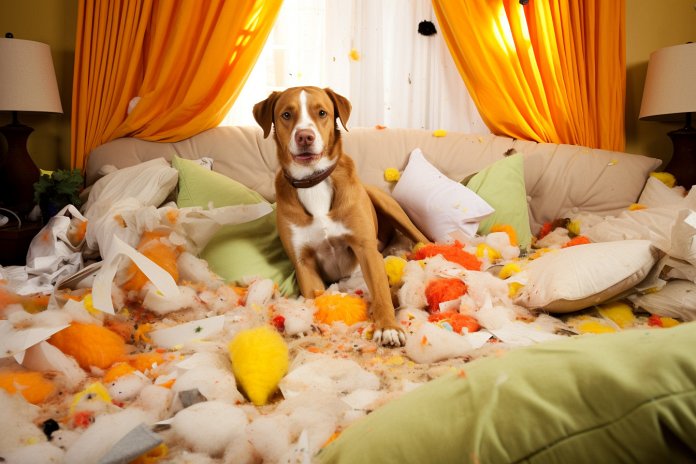
Doggy destruction is a common issue that can result in extra expenses when your dog decides to chew on your furniture. It can be stressful to leave the house knowing that your rescue pup might destroy your belongings. There are several reasons why dogs become destructive, and it’s important to understand them. In this article, we will explore the signs that your dog may be destructive, the reasons behind their destructive behavior, and how to train them to stop.
Signs a Puppy Can be Destructive
One of the first signs that your dog is a chewer is finding your slippers in bits or your furniture legs damaged. Puppies, especially when they are teething between 14 and 30 weeks, tend to chew more. Providing them with rubber and rawhide toys can help redirect their chewing behavior. However, some breeds may continue to be avid chewers even as adults. Golden retrievers, Beagles, Jack Russell terriers, and Australian shepherds are breeds that are more prone to destructive chewing.
When your puppy chews on everything in sight, it may be a sign of boredom or separation anxiety. It’s important to provide them with appropriate toys and mental stimulation to prevent destructive behavior.
History of Why Dogs Love Chewing
Dogs have a natural instinct to chew, which can be traced back to their evolutionary ancestors. Dogs’ ancestors were pack animals that hunted larger prey, and their strong jaws and teeth allowed them to consume meat. Even though dogs have been domesticated, their desire to chew on bones or objects resembling bones has remained. Additionally, dogs can develop anxiety or compulsive behavior due to poor breeding conditions or past trauma.
Training a Destructive Dog
Rescue dogs or dogs with a history of abuse may exhibit destructive behavior due to a lack of guidance and boundaries. Setting up a puppy-proof area and providing interactive toys can help redirect their destructive tendencies. If separation anxiety is the cause of their destructive behavior, it’s important to address the anxiety and seek professional help if needed.
Teaching your dog not to destroy your belongings should be done through positive reinforcement, rather than punishment. Offering them appropriate chew toys and praising them when they chew on those toys can help redirect their chewing behavior. There are also deterrent sprays available that can be used on items they tend to chew on.
Ultimately, it’s important to create a safe and stimulating environment for your puppy to prevent destructive behavior. If your puppy continues to exhibit destructive behavior, consult with a veterinarian or a dog trainer who specializes in behavior issues.
Safety Tips for Puppies Who Love to Chew:
– Create a designated safe zone or use baby gates to limit their access to certain areas.
– Supervise your puppy when they are free-roaming.
– Puppy-proof your home by removing items that could be tempting for them to chew on.
– Use deterrent sprays on items they should avoid chewing.
– Avoid using physical punishment like hitting.
– Put away items that are especially appealing to your puppy, such as shoes.
– Teach them to chew on bones or toys instead of household items.
– Consult with a veterinarian or dog trainer if your puppy has separation anxiety.
“Understanding the underlying reasons behind destructive behavior is key to helping your furry friend find healthier outlets for their chewing instincts.”

Tips & Things to Know
1️⃣ Provide appropriate chew toys: If you have a puppy or a dog that loves to chew, make sure to provide them with appropriate chew toys. Rubber and rawhide toys are great options for puppies. Avoid giving them items that resemble things they should not chew, like fluffy throw pillows or shoes.
2️⃣ Understand the signs of destructive behavior: Be aware of the signs that your dog may be feeling destructive, such as barking, digging, whining, panting, and chewing on shoes, furniture, or walls. These behaviors can indicate boredom, teething, separation anxiety, or a need for more exercise and mental stimulation.
3️⃣ Use positive reinforcement for training: When teaching your dog not to chew on inappropriate items, use positive reinforcement instead of punishment. Offer them chew bones or toys instead and praise them when they choose to chew on those items. If they do chew on something they shouldn’t, gently redirect them and provide them with an appropriate alternative.
Frequently Asked Questions, Answered ✅
1. Why do dogs chew on furniture and other items?
– Dogs may chew on furniture and other items due to frustration, psychological hangovers from an abusive past, teething, boredom, separation anxiety, or certain breeds being predisposed to chewing.
2. How can you tell if your dog is feeling destructive?
– Signs that a dog may be feeling destructive include barking, digging, whining, panting, howling, wagging tail, drooling, paw raised, play bowing, and chewing on shoes, furniture, or walls.
3. What is the history behind why dogs love chewing?
– Dogs have a natural instinct to chew, which can be traced back to their ancestors who were pack animals and hunted larger prey. Chewing on bones and other objects may be a way for dogs to fulfill their genetic need to chew.
4. How can you train a destructive dog to stop chewing?
– It is important to use positive reinforcement and redirect your dog’s chewing behavior to appropriate chew toys or bones. Punishment methods should be avoided as they can worsen the problem. Consulting with a vet and dog trainer experienced in dealing with destructive behavior can also be helpful.
5. What are some safety tips for puppies who love to chew?
– Create a safe zone using a room or baby gates, supervise your puppy when they are roaming freely, puppy-proof your home, use deterrent sprays on items they can’t resist chewing, never hit a puppy, put away favorite chewing items like shoes, and teach them to chew bones or toys instead of household items. If your puppy has separation anxiety, consult with a vet and dog trainer for guidance.